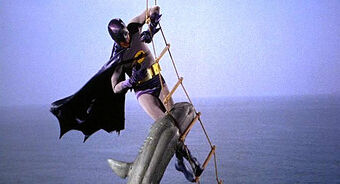
Posted on 01/10/2020 12:28:08 PM PST by Capt. Tom
The sky was winter gray, but researchers took advantage Friday of a relatively rare day with calm seas and little wind to retrieve 18 acoustic shark detection buoys off the Outer Cape and another eight or nine in Cape Cod Bay. Although these buoys primarily record signals from sharks whose tags emit a unique identifying signal, they also record water temperature.
Shark researchers Gregory Skomal of the state Division of Marine Fisheries and Megan Winton, a doctoral candidate at the University of Massachusetts Dartmouth’s School of Marine Science and Technology, hope to use this temperature data to create a computer model that will act like a weather forecast in predicting the likelihood of sharks being at any particular beach on any given day. snip...….
Skomal and Winton have about a decade of buoy data to comb through. They hope to compare the readings on their buoys to satellite data that measures sea surface temperature. Once they discern a pattern for temperature, they plan to look at other potential environmental factors such as water clarity, which they also can check against satellite data that uses reflected wavelengths to estimate the amount of chlorophyll in sea water that is indicative of plankton blooms that diminish visibility. They hope to layer in other factors, such as time of day, angle of the sun and the tide cycle to tease out other patterns and build a model that can use environmental conditions in the ocean to predict where sharks are more or less likely to be present. If the models prove able to discern patterns in white shark movements in response to detectable environmental factors, Winton said they may be able to add real-time data loggers to the buoys and have mini-ocean weather stations at beaches. snip ….
(Excerpt) Read more at capecodtimes.com ...
So far we have not had a coastal roaring Noreaster. This means they can analyze November and December buoy pings and see if any sharks were around. - Tom
Maybe start with wherever the seal colonies are...
Can’t you tell when the music starts playing?

You’ll let us know where? We need to know when we fly Democrats out to sea... I’m not sure we can believe that they still cruise the old slave ship routes, like Leftists say...
I predict most of them will be found in the water near food sources..................
There is just so much we can learn from Sharks.
They’re working on faster than light travel.
The baby shark song?
It’s almost like you’re clairvoyeur or something.
Do you have any lottery picks?
info- Hydrophones are underwater sound receivers placed strategically by many different groups of marine researchers to receive signals (pings) from acoustic tags placed on or inside various ocean species.
When an acoustic tagged species gets within a thousand feet, or less, depending on the condition of the water, the tags and hydrophone, the hydrophone records the date and time of the ping, and the unique signal indicates what tagged individual and species was involved.
Why not count the number of seals on Monomoy?
I only use my powers for good.....................
In before the “We’re gonna need a bigger boat” meme.. d;^)
I think it would be good if I won a lot of money.
Last summer I was at a local beach here in Mass. and I said to my wife; "Can you imagine if someone had a Boom Box on the beach and loudly played the Jaw's theme how many panicky people would run out of the water to get ashore". - Tom
How many great whites does it take to keep exploding seal colonies in check?
Do the sensors detect “the presence of food”? I suspect that’s the biggest factor in whether sharks are present in a given area. Just sayin’
Because white sharks don't feed that often I don't believe they can control a breeding seal colony, like the ones on Cape Cod.
From my website- Biologists tell us white sharks can go more than a month between feedings-if necessary. I am sure if the pickings were easy, like they are at some seal colonies, the white sharks would eat more often than that. I decided to check on the white shark feeding interval, and here is an e-mail exchange between me and others on a shark list.
My question is, "What is the shortest time between SUCCESSFUL feedings of an individual white shark have you witnessed?" - Tom
I got this answer from Sean R. Van Sommeran, Executive Director/CEO, The Pelagic Shark Research Foundation in California. (ANI is most likely Sean's abbreviation for Ano Nuevo Island, in California.)
"There is one shark we know from ANI that was involved in at least 3 seal predations within a span of less than 30 days, mind you this 30 day window involved an observer and site presence (boatbased) of about 4-7 hours per day (sun up til it gets choppy/windy) and a few days were scrubbed due to rough spells during this time frame. The shark is an adult female est at 5meters, we saw her feeding on all three occasions. taking 3 to 8 bites respectively,(30-80lbs?).
Tom here- so it looks like 3-4 seals a month per white shark, and IMHO that won't dent the 50,000 breeding seals here in Mass. - Tom
Disclaimer: Opinions posted on Free Republic are those of the individual posters and do not necessarily represent the opinion of Free Republic or its management. All materials posted herein are protected by copyright law and the exemption for fair use of copyrighted works.